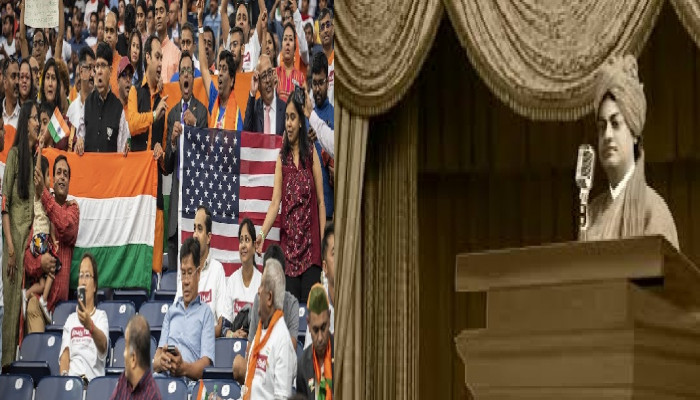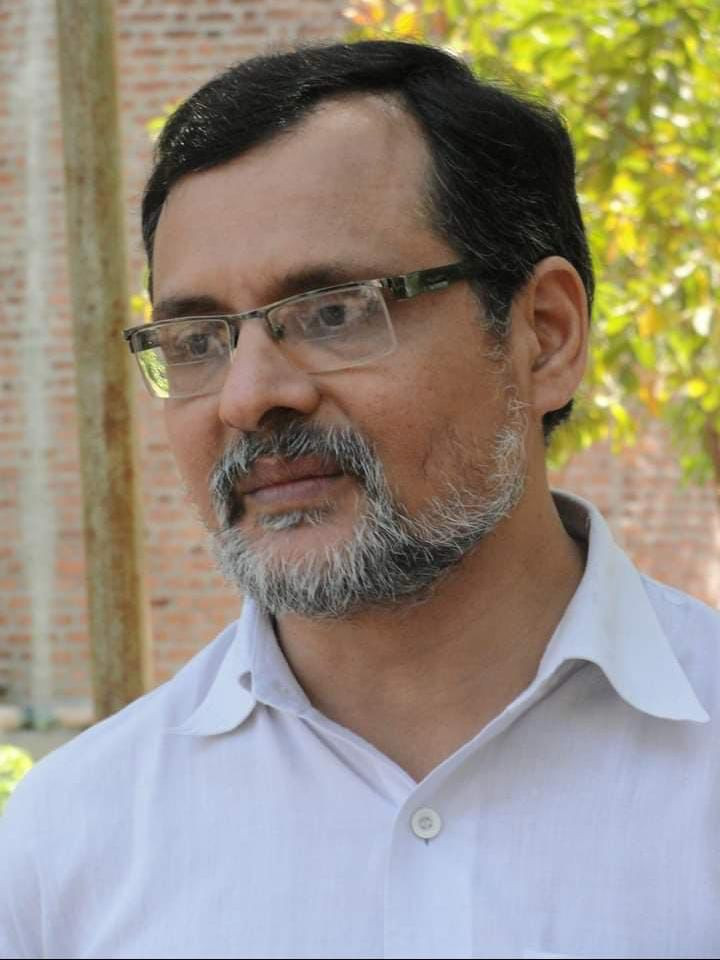'Dear American Brothers and Sisters': Heritage of Unity, Non-Violence, and Inclusive Resilience on 9/11
- In Current Affairs
- 12:59 PM, Sep 12, 2025
- Viren S Doshi
Dispelling Myth and Propaganda About India, Indian Americans and Hindu Americans
“Dear American Brothers and Sisters”
On September 11, 1893, a Hindu monk from India, Swami Vivekananda, stood before the World’s Parliament of Religions in Chicago and delivered a speech that resonates through history. His words bridged the philosophies of the East and West, fostering mutual understanding and respect. This date, now overshadowed by the tragic events of September 11, 2001, when radical Islamic terrorists attacked the World Trade Centre, now carries even more significance. While America mourns the thousands of innocent lives lost, this is the moment to reflect on the enduring message of unity and shared values brought by Swami Vivekananda—a message that Indian Americans and Hindu Americans continue to embody.
Yet, these communities often face misconceptions, fuelled by a mix of leftist narratives, fringe supremacist ideologies, and historical distortions.
This article seeks to dispel these myths, highlighting the vibrant contributions of Indian Americans and Hindu Americans to the United States and the world, while reaffirming their commitment to global peace and the shared ideals of America’s Founding Fathers.
The Legacy of Swami Vivekananda: A Bridge Between East and West
Swami Vivekananda’s address on September 11, 1893, was a clarion call for universal tolerance and the recognition of shared divinity across humanity. Drawing from the ancient wisdom of the Vedas and Upanishads, he declared, “Every soul is potentially divine,” emphasising the unity of all beings despite diverse paths to the divine. His teachings focused on the universal values that were championed by American luminaries like Ralph Waldo Emerson, who drew inspiration from Indian philosophy, and Martin Luther King Jr., whose vision of equality echoed Vedic principles of seeing God in every living being. Vivekananda’s message resonates with the ideals of America’s Founders—George Washington, John Adams, and Benjamin Franklin—who envisioned a nation built on liberty, justice, and the pursuit of truth.
Indian Americans and Hindu Americans, as torchbearers of this legacy, continue to foster harmony and mutual respect. Their contributions to science, technology, medicine, academia, economy and civic life reflect a commitment to these shared values, enriching the American fabric while upholding the principles of global peace.
Bill Drexel, an analyst at Hudson Institute, recently said that India is as important for America as Israel is. He lamented that there is a paucity of advocacy or diplomacy, or representation in the corridors of Washington to put the case of India in proper perspective. Let us do our bit along with the efforts of Americans like Salvatore Babones, Mary Millben, Mike Watson, Walter Russell Mead, Jason Isaacson, Daniel Di Martini, T. Greer, Renee Lynn, Amy Mek and many others.
Myth: Hindus Are Pagans and Polytheists with “Animal Gods”
One of the most persistent myths about Hinduism is that it is a pagan, polytheistic religion centred on “animal gods” or “demi-gods.” This misconception stems from a superficial understanding of Hindu Dharma, often perpetuated by external forces seeking to caricature a complex spiritual tradition. At its core, Hinduism is rooted in the Vedic principle of “Ekam Sat, Vipra Bahudha Vadanti” —the truth is one, though the wise call it by many names. The Vedas affirm the existence of one Supreme Reality, manifested in diverse forms to accommodate humanity’s varied spiritual inclinations.
Hinduism’s apparent multiplicity—its reverence for deities like Ganesha, Saraswati, or Vishnu—is not polytheism but a democratic embrace of diversity within unity. Each deity represents an aspect of the Divine, much like facets of a single jewel. For example, Ganesha, often depicted with an elephant head, symbolises wisdom and the removal of obstacles, not a literal “animal god.” This symbolic richness is misunderstood by those who fail to grasp the profound metaphysical framework of Hindu thought. Swami Vivekananda himself clarified this, emphasising that Hinduism’s liberal structure allows for diverse sects to coexist harmoniously, united by the shared pursuit of truth.
Myth: The Caste System Defines and Divides Hindu Society
Another pervasive myth is that Hindu society is rigidly divided by a hierarchical caste system, often portrayed as an oppressive structure rooted in birth privilege. This malicious narrative, amplified by a nexus of leftist, colonialist, and divisive forces, distorts the historical and philosophical reality of the “Varna” system. Originally, the Varna system was a division of labour based on aptitude and contribution to society, not a rigid hierarchy determined by birth. The four Varnas—Brahmins (scholars and priests), Kshatriyas (warriors and rulers), Vaishyas (merchants and farmers), and Shudras (artisans and labourers)—were meant to ensure societal balance, with each role valued equally.
Over time, external invasions and colonial policies ossified this flexible system into a rigid caste structure, creating divisions that were alien to its original intent. Independent India has taken significant steps to rectify these distortions through affirmative action, education, and social reforms. Indian Americans, in particular, have moved beyond caste-based identities, embracing a modern ethos rooted in merit and unity. The accusation of caste as a defining feature of Hindu society is often weaponised to vilify Hindus, ignoring the community’s resilience in addressing historical challenges and its commitment to inclusivity.
Myth: Indian Americans and Hindus Are “Snake Charmers” or “Cow Urine Drinkers”
Stereotypes like “snake charmers” or “cow urine drinkers” are rooted in outdated colonial tropes that reduce a billion-plus brilliant, benevolent people to caricatures. These labels, often perpetuated by leftist Jihadi media or fringe narratives, fail to capture the sophistication of Indian culture and the contributions of Indian Americans. India is a global leader in technology, science, and innovation, with Indian Americans playing pivotal roles in Silicon Valley, NASA, academia, and healthcare. The stereotype of the “snake charmer” ignores the fact that India’s contributions to mathematics (like the concept of zero), astronomy, and philosophy have shaped global civilisation.
The “cow urine” trope misrepresents the reverence for cows in Hindu culture, which stems from their role as a source of sustenance in an agrarian society. While traditional Ayurvedic practices may use cow products for their medicinal properties, this is one aspect of a vast, scientifically grounded system of holistic medicine. Such stereotypes are often amplified to demean Hindus, ignoring their deep respect and reverence for all life forms and their contributions to modern science and wellness.
Myth: Hindu Americans and Indian Americans Are a Monolith
Not all Indian Americans are Hindus, and not all Hindus are Indian. The Indian American community includes Jains, Buddhists, Sikhs, and even sections of pragmatic Muslims, Christians, and others, all of whom share a cultural affinity rooted in India’s pluralistic ethos. Similarly, Hinduism, while non-proselytising, attracts followers globally, including in the United States, where non-Indian Hindus contribute to the faith’s diversity. This pluralism is a strength, reflecting the inclusive spirit of Hindu Dharma, which accommodates diverse beliefs without enmity.
The assumption of a monolithic identity ignores the community’s diversity and its ability to unite around shared values. Indian Americans and Hindu Americans are bound by a commitment to “Vasudhaiva Kutumbakam” — the world is one family — a principle that aligns with America’s melting pot ideal and fosters cross-cultural understanding.
Myth: Hindus Are Inherently Violent
A dangerous and unfounded myth portrays Hindus as violent or linked to terrorism, often conflating isolated political extremism with the core tenets of Hindu Dharma. In reality, Hindu Dharma is fundamentally non-proselytising and non-violent, with no place for terrorism or violence in its philosophical framework. The principle of “Ahimsa” (non-violence) is a cornerstone of Hinduism, extending compassion and respect to all living beings—not just through actions but also in thoughts and words. As articulated in ancient texts like the Upanishads, Ahimsa promotes peaceful conflict resolution, self-control, and the pursuit of harmony, influencing global figures like Mahatma Gandhi and Martin Luther King Jr. in their non-violent struggles for justice.
Hindus have historically never invaded other lands in the name of religion or culture, and over millennia, Hindu-majority societies in Southeast Asia have fostered environments of absolute pluralism, enabling peaceful coexistence among Hinduism, Buddhism, Judaism, Christianity, Sikhism, Jainism, and Zoroastrianism and many other nature-worshipping sects as well as certain pragmatic versions of Islam. All persecuted religious groups have found India as the best shelter. Terrorism and violence are antithetical to Hindu thinking, which views all life as sacred and interconnected. Indian Americans and Hindu Americans embody this ethos as peace-loving, law-abiding, and pragmatic people, deeply loyal to the lands they inhabit. They respect and actively contribute to the American open, liberal, and free system—through innovation, civic participation, and community service—strengthening the very foundations of democracy and pluralism that define the nation.
Myth: Hindus Are Intolerant or Unaccommodating of Diversity
Contrary to claims that portray Hindus as insular or intolerant, Hindu Dharma is naturally and spontaneously accommodative of human diversity, with a remarkable history of embracing and assimilating varied communities. This adaptive resilience is evident in India’s millennia-long tradition of providing refuge and integration to some of the oldest communities, such as Jews, Parsis (Zoroastrians), and early Christians, who arrived on Indian shores fleeing persecution. These groups were not only welcomed but seamlessly woven into the cultural and social fabric of Hindu society, thriving without losing their distinct identities. For instance, the Jewish community in India, one of the oldest in the world, faced no persecution, and Parsis found a home where they could preserve their traditions while contributing to India’s progress. Early Christian communities, such as those in Kerala, similarly flourished in harmony with Hindu neighbours.
This inclusive spirit stems from Hinduism’s non-proselytising nature, which does not seek to convert but to coexist, celebrating diversity as a reflection of the Divine. Indian Americans and Hindu Americans carry this legacy forward, embracing the multicultural ethos of the United States and fostering mutual respect across communities. Their ability to adapt and integrate while maintaining their cultural roots strengthens America’s pluralistic society.
Confronting Divisive Narratives
Indian Americans and Hindu Americans face challenges from a confluence of leftist, supremacist, and colonialist narratives that seek to marginalise them. These narratives often exploit myths about caste, paganism, or cultural stereotypes to paint Hindus as “other.” Such tactics echo historical leftist and colonial strategies that sought to divide India’s pluralistic society on certain faultlines. However, the resilience of the Hindu American community, guided by the timeless wisdom of the Vedas, has rendered these divisive efforts largely ineffective. Far from being fragmented, Hindu Americans and Hindus and Indians in general are more united than ever, actively countering misinformation through education, dialogue, and community engagement.
A Shared Vision for Global Peace
The mission of Indian Americans and Hindu Americans extends beyond dispelling myths — it is a continuation of Swami Vivekananda’s vision of uniting East and West. Their contributions to America’s prosperity, from technological innovation to cultural enrichment, Yoga and Ayurveda, STEM sectors reflect the universal values of liberty, justice, and compassion championed by both Hindu Dharma and America’s Founding Fathers.
In an era of global challenges, their commitment to seeing divinity in all beings and their inclusive, non-violent ethos offer a path to peace, echoing the aspirations of Emerson, Lincoln, and King.
On this dual 9/11, as we honour the victims of tragedy and celebrate the enduring wisdom of Swami Vivekananda, let us recognise the Indian American and Hindu American communities as vital bridges between cultures.
By dispelling myths and embracing truth, we can build a future where shared values triumph over division, fostering a world that is truly one family.
For further information on Indian American and Hindu American contributions, explore resources at organisations like the Hindu University of America (hua.edu), Hindu American Foundation (hafsite.org), COHNA, USIRC, USISP Forum or delve into Swami Vivekananda’s works, available through the Vedanta Society. Let us move forward with clarity, unity, confidence and purpose.
Disclaimer: The opinions expressed within this article are the personal opinions of the author. MyIndMakers is not responsible for the accuracy, completeness, suitability, or validity of any information on this article. All information is provided on an as-is basis. The information, facts or opinions appearing in the article do not reflect the views of MyindMakers and it does not assume any responsibility or liability for the same.







Comments